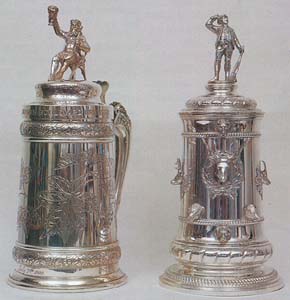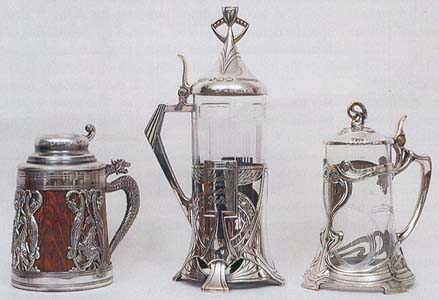
by Stephen L. Smith
In Europe in the early 1700s, the social status of beer and wine drinkers was evidenced in the materials from which their drinking vessels were made. This had been going on for the hundreds of years of the medieval period. The royals, nobles and very wealthy used silver or imported Chinese porcelain. The merchant class used pewter and some rough forms of decorated stoneware. The peasant class used and re-used pewter and crude undecorated stoneware, or carved out wood for their beer drinking containers.
 |
Prior to Thomas’ discovery, plating was accomplished using either a method known as French plating, which involved the use of a heated silver foil applied by hammer to a heated surface, or by close plating, which used tin as a flux under the silver foil. There was also vemeil, which was plating in gold, usually over silver, and using mercury as a processor. The new process was quickly accepted and stormed England and the continent where fused plated drinking vessels were made for about the next one hundred years.
In 1768, a Mr. Vickers introduced what he called white metal, but which came to be known as Britannia metal. The ads at the time made Britannia metal sound like something really new, but it was not. It was tin and copper, which equates to pewter with a larger dose of antimony. It was not so much a new material as it was a new process. The steins and other products using this metal were spun, simply by hammering a sheet of metal around a mold which was attached and spinning on a lathe. This mode of power was of course the result of the industrial revolution and was a dramatic step beyond the pouring of pewter into molds and soldering the parts together to make a beer stein.
Spun Britannia ware was so shiny, durable and such a rage that it caused the Sheffield platers to reduce the proportion of silver used in the final ingot in order to reduce costs. Therefore, the fused plate produced in the British Isles and on the continent was much thinner between 1820 and 1850. But it was all for naught because in 1840 in the town of Birmingham, England, two industrious brothers named Elkington were fooling around with silver nitrate in a solution with charged electrodes. They invented and refined the electro-plating process and, as we say, the rest is history! Within ten to fifteen years their patented secret was known and electrosilver manufacturing plants were being established in France, Germany and of course the U.S.A. It drove the pewterers, and the Sheffield platers, completely out of the home goods market by 1880. Only some of the pewterers specializing in Art Nouveau were able to stay in business to the century’s close.
 |
In the U.S.A., all types of electroplated wares were in demand. Lidded tankards (what we call steins) were primarily made for the German-American communities, but they usually demonstrated high-quality design and conformed to existing European standards. The largest American manufacturer, The Meridan Britannia Company (later to become one of the principals in the International Silver Company), produced a large variety of silver-plated drinking vessels. The wording quadruple plate on the impressed base mark was assurance of top quality and meant the stein produced had been through the electrosilver plating process four times. The purpose of passing an object through silver plating four times was to assure that all areas were covered with silver. However, this did not mean that the piece had the equivalent of four layers of pure silver over the base metal.
__________
*Reprinted from The Beer Stein Journal, May 1995, by permission from Gary Kirsner Auctions.